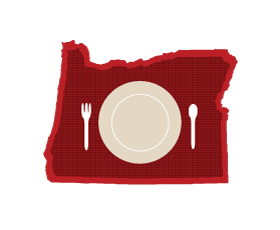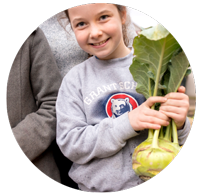Farm to school is transforming Oregon—generating $21 million for our communities, 100+ jobs, and feeding 312000 kids.

Source: $21 million and 100+ jobs = estimated economic impact of local purchasing by school districts in the 2011-2012 school year, as arrived at via research conducted by Ecotrust. Average daily lunch participation was 312,076 for all of the school districts that opted into the state farm to school procurement grant program in the 2019-2020 school year.
Welcome!
There is a growing community of schools, connected through the Oregon Farm to School and School Garden Network, committed to putting more money in the pockets of Oregon's farmers, teaching students about farm fresh foods, increasing access to local healthy foods in schools and preschools, and stewarding the land for future generations. Because of their work, kids, families, and communities are reaping the benefits. We are proud to share our impact in four key areas:
Health
In Oregon, 49% of kids qualify for free and reduced lunch.
That means that often, school lunch is the most reliable source of food that Oregon kids have. It’s a critical meal, and deserves to be as good as we can possibly make it. Luckily, schools are stepping up to the challenge. In the 2018-2019 school year, 131 school districts, serving approximately 93% of Oregon school meals, included healthy, local food in those meals.

Source: According to the Oregon Department of Education, there are approximately 581,730 students in Oregon in grades K-12. Of those, 93% attend school in districts that have opted into the state farm to school procurement grant program.
Education
Oregon farm to school grants for food literacy reach 39,246 students.
In 2019, over 380 teachers, parents, food service staff, and other community partners received training to run farm to school programs in their own communities. In 2019, 24 school districts and community partners received state grant funds to run educational programs. These farm to school trailblazers are not only teaching kids about food, but are also using food as a gateway into learning about all sorts of subjects, from math to art literacy. These educational opportunities have the added benefit of increasing the likelihood that kids will try and like new fruits and vegetables, since it usually takes at least eight exposures to a new food before a child is ready to like it.

Source: Approximately 39,246 children were reached by Farm to School Education grants awarded in 2019, as reported by Oregon Department of Education Farm to School Education grantees on their Grant Progress Reports covering the 2019-2020 School Year. Over 380 stakeholders received training at the Oregon Farm to School and School Garden Conference and Regional Hub Gatherings in 2019-2020, according to the Oregon Farm to School and School Garden Network. Children usually need at least eight exposures before they like a food, according to Anzman-Frasca S, Savage JS, Marini ME, Fisher JO, Birch LL, 2012 and Lakkakula A, Geaghan J, Zanovec M, Pierce S, Tuuri G, 2010.
Economy
In 2021, Oregon decided to invest $10.2 million, and the benefits are rippling across the entire state economy.
When it comes to Oregon's economy, the impact of school food is on the rise: in 2018-2019 school year, Oregon schools spent about a quarter of their budget on local food. Farm to school generated more than $21 million and 100 jobs in the 2011-2012 school year. But, there's more work to be done, including working intentionally to make these economic benefits available to everyone across the supply chain and identifying opportunities to support socially disadvantaged producers, farm workers, and laborers.

Source: $21 million and 100 jobs= Economic impact analysis conducted by Ecotrust.
Environment
780 K-12 schools have gardens—that's approximately 51% of all schools in the state!
From growing school gardens, to sustainable food purchasing and composting, farm to school is an earth friendly practice. Gardens and cafeterias are essential classrooms where students can learn about everything from water quality and ecosystem services to composting and reducing food waste. In fact, at least 507 of Oregon’s school gardens are used to support curriculum, strengthening students' environmental literacy and ecological ethics.

Data Gaps
We still lack adequate data for nearly half of the 60+ measures that are statewide priorities in Oregon.
Some of the most important aspects of our work are also the most difficult to measure. From farm to school’s impact on parents and families, to the percentage of sales that benefit socially-disadvantaged producers, there’s a lot more that we could learn from continued research and evaluation.



Statewide priorities were determined by the Oregon Farm to School and School Garden Network. Read all goals here.



